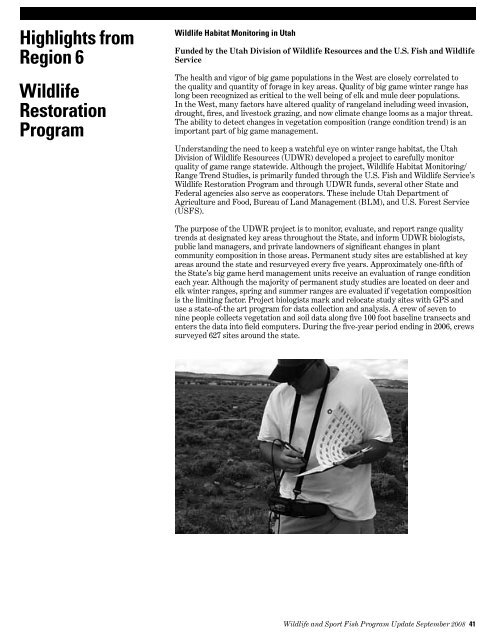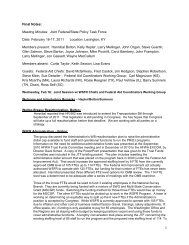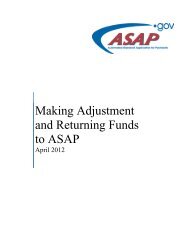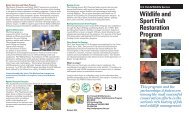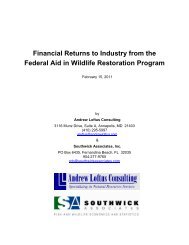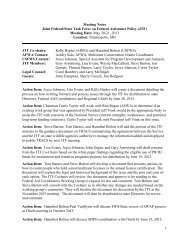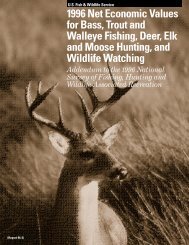Program Update - Wildlife and Sport Fish Restoration Program - U.S. ...
Program Update - Wildlife and Sport Fish Restoration Program - U.S. ...
Program Update - Wildlife and Sport Fish Restoration Program - U.S. ...
You also want an ePaper? Increase the reach of your titles
YUMPU automatically turns print PDFs into web optimized ePapers that Google loves.
Highlights from<br />
Region 6<br />
<strong>Wildlife</strong><br />
<strong>Restoration</strong><br />
<strong>Program</strong><br />
<strong>Wildlife</strong> Habitat Monitoring in Utah<br />
Funded by the Utah Division of <strong>Wildlife</strong> Resources <strong>and</strong> the U.S. <strong>Fish</strong> <strong>and</strong> <strong>Wildlife</strong><br />
Service<br />
The health <strong>and</strong> vigor of big game populations in the West are closely correlated to<br />
the quality <strong>and</strong> quantity of forage in key areas. Quality of big game winter range has<br />
long been recognized as critical to the well being of elk <strong>and</strong> mule deer populations.<br />
In the West, many factors have altered quality of rangel<strong>and</strong> including weed invasion,<br />
drought, fires, <strong>and</strong> livestock grazing, <strong>and</strong> now climate change looms as a major threat.<br />
The ability to detect changes in vegetation composition (range condition trend) is an<br />
important part of big game management.<br />
Underst<strong>and</strong>ing the need to keep a watchful eye on winter range habitat, the Utah<br />
Division of <strong>Wildlife</strong> Resources (UDWR) developed a project to carefully monitor<br />
quality of game range statewide. Although the project, <strong>Wildlife</strong> Habitat Monitoring/<br />
Range Trend Studies, is primarily funded through the U.S. <strong>Fish</strong> <strong>and</strong> <strong>Wildlife</strong> Service’s<br />
<strong>Wildlife</strong> <strong>Restoration</strong> <strong>Program</strong> <strong>and</strong> through UDWR funds, several other State <strong>and</strong><br />
Federal agencies also serve as cooperators. These include Utah Department of<br />
Agriculture <strong>and</strong> Food, Bureau of L<strong>and</strong> Management (BLM), <strong>and</strong> U.S. Forest Service<br />
(USFS).<br />
The purpose of the UDWR project is to monitor, evaluate, <strong>and</strong> report range quality<br />
trends at designated key areas throughout the State, <strong>and</strong> inform UDWR biologists,<br />
public l<strong>and</strong> managers, <strong>and</strong> private l<strong>and</strong>owners of significant changes in plant<br />
community composition in those areas. Permanent study sites are established at key<br />
areas around the state <strong>and</strong> resurveyed every five years. Approximately one-fifth of<br />
the State’s big game herd management units receive an evaluation of range condition<br />
each year. Although the majority of permanent study studies are located on deer <strong>and</strong><br />
elk winter ranges, spring <strong>and</strong> summer ranges are evaluated if vegetation composition<br />
is the limiting factor. Project biologists mark <strong>and</strong> relocate study sites with GPS <strong>and</strong><br />
use a state-of-the art program for data collection <strong>and</strong> analysis. A crew of seven to<br />
nine people collects vegetation <strong>and</strong> soil data along five 100 foot baseline transects <strong>and</strong><br />
enters the data into field computers. During the five-year period ending in 2006, crews<br />
surveyed 627 sites around the state.<br />
<strong>Wildlife</strong> <strong>and</strong> <strong>Sport</strong> <strong>Fish</strong> <strong>Program</strong> <strong>Update</strong> September 2008 41


